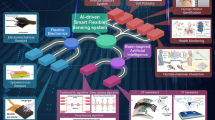Abstract
Living creatures have evolved and formed ecological systems by adapting to their dynamic environment. Robots also need an adaptability to the dynamic environment. This paper presents methodologies for adaptation, learning, and evolution in robotics. Further the intelligence of a robot emerges as a result of the synthesis of simultaneous processing of perception, decision making, and action. A robotic system requires the whole structure of intelligence, and acquires skill and knowledge through interaction with the dynamic environment by computational intelligence, including neural networks, fuzzy systems, and genetic algorithms.
Similar content being viewed by others
References
Russell S, Norvig P (1995) Artificial intelligence Prentice-Hall Englewood Cliffs
Zurada J, Marks II RJ, Robinson CJ (1994) Computational intelligence —imitating life. IEEE Press, New York
Palaniswami M, Attikiouzel Y, Marks II R, et al. (1995) Computational intelligence—a dynamic system perspective, IEEE Press, New York
Jang J, Sun C, Mizutani E (1997) Neuro-fuzzy and soft computing. Prentice-Hall, Englewood Cliffs
Langton C (1995) Artificial life—an overview, MIT Press, Cambridge
Anderson J, Rosenfeld E (1988) Neurocomputing—foundations of research. MIT Press, Cambridge
Fogel D (1995) Evolutionary computation. IEEE Press, New York
Brooks R (1986) A robust layered control system for a mobile robot. IEEE J Robotics Autom RA-2–1:14–23
Colombetti M, Dorigo M, Borghi G (1996) Behavior analysis and training—a methodology for behavior engineering, IEEE Trans Syst. Man. Cybern. B, Cybern 26:365–380
Tani J (1996) Model-based learning for mobile robot navigation from the dynamical systems perspective IEEE Trans Syst, Man. Cybern. B, Cybern 26:421–436
Kubota N, Arakawa T, Fukuda T, Shimojima K (1997) Motion planning for a robotic system with structured intelligence. Proceedings of the 1997 IEEE International Symposium on Computational Intelligence in Robotics and Automation, pp 60–65
Author information
Authors and Affiliations
About this article
Cite this article
Fukuda, T., Kubota, N. Intelligent robotic systems: Adaptation, learning, and evolution. Artif Life Robotics 3, 32–38 (1999). https://doi.org/10.1007/BF02481485
Received:
Accepted:
Issue Date:
DOI: https://doi.org/10.1007/BF02481485




